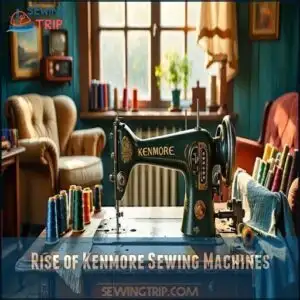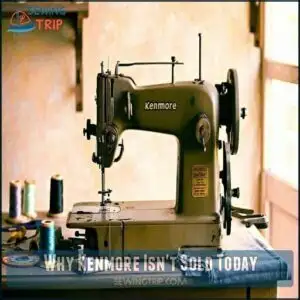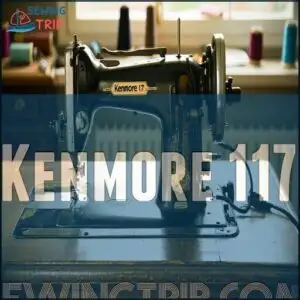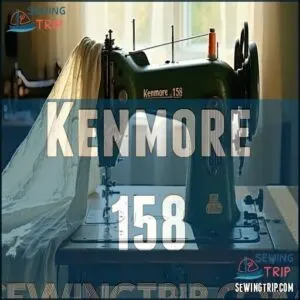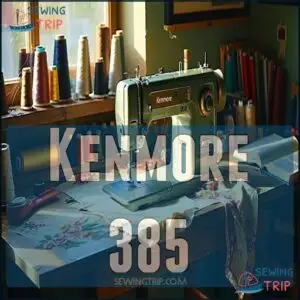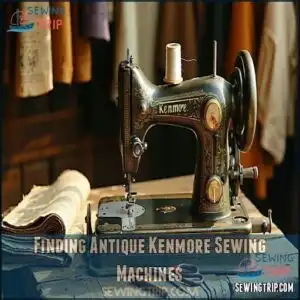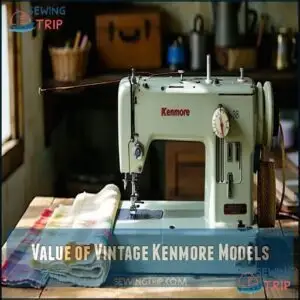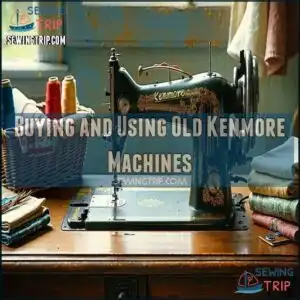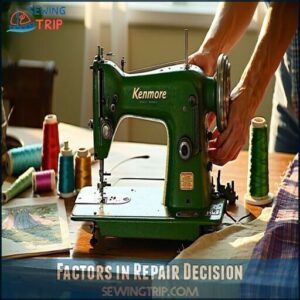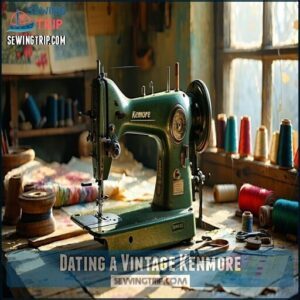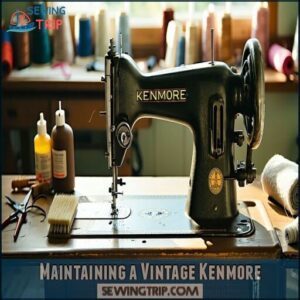This site is supported by our readers. We may earn a commission, at no cost to you, if you purchase through links.
 You’ve likely seen Kenmore sewing machines humming in your grandmother’s craft room.
You’ve likely seen Kenmore sewing machines humming in your grandmother’s craft room.
These iconic appliances, exclusively sold through Sears from the early 1900s to 2018, were more than just machines—they were family heirlooms.
You’ll find models like the legendary 117 and 158 that powered through decades of fabric and fashion.
Whether you’re a vintage sewing enthusiast or curious about American manufacturing history, Kenmore machines represent a golden era of home crafting.
They transformed sewing from a necessity to an art form, letting families create, mend, and express themselves stitch by stitch.
Want to know how these machines became household legends?
Table Of Contents
- Key Takeaways
- Rise of Kenmore Sewing Machines
- Why Kenmore Isn’t Sold Today
- Most Popular Vintage Kenmore Models
- Finding Antique Kenmore Sewing Machines
- Value of Vintage Kenmore Models
- Buying and Using Old Kenmore Machines
- Case Study: 117-959 Model
- Factors in Repair Decision
- Dating a Vintage Kenmore
- Maintaining a Vintage Kenmore
- Frequently Asked Questions (FAQs)
- Conclusion
Key Takeaways
- You’ll discover Kenmore sewing machines were a century-long manufacturing marvel, produced from 1913 to 2013 through strategic partnerships with companies like White, Singer, and Janome.
- If you’re a vintage sewing enthusiast, you’ll find models like the 117, 158, and 385 series are now collectible treasures, valued between $175 to $700 and prized for their durability and mechanical precision.
- You’ll learn that Sears’ bankruptcy in 2018 permanently ended Kenmore’s sewing machine production, transforming these once-common household tools into cherished historical artifacts.
- When hunting for a vintage Kenmore, you’ll want to carefully inspect the machine’s condition, verify its authenticity through serial number research, and assess maintenance needs to determine its true value and potential for restoration.
Rise of Kenmore Sewing Machines
In the bustling landscape of early 20th-century America, Sears revolutionized home sewing with their first Kenmore sewing machines in 1913.
These affordable marvels quickly transformed how everyday families approached clothing and crafts. By strategically partnering with manufacturers like White and Janome, Sears created machines that were both innovative and accessible.
The Kenmore sewing machine: where American innovation meets household creativity, empowering families one stitch at a time.
Early Kenmore models weren’t just tools—they were gateways to creativity, offering reliable performance at prices that made sewing achievable for everyone. From treadle-powered designs to electric wonders, these machines captured the spirit of American manufacturing.
Each Kenmore model represented more than just a sewing machine; it symbolized possibility, empowering home sewers to turn fabric into art. The brand’s commitment to design evolution and production techniques set new standards in the sewing machine industry.
Why Kenmore Isn’t Sold Today
You might wonder why such an iconic sewing machine brand disappeared from store shelves after a century of success.
Kenmore’s production ceased due to Sears’ bankruptcy in the early 2000s, ending its long-standing manufacturing partnerships with companies like Janome that had produced its beloved machines.
Sears Bankruptcy
Emerging from years of financial struggle, Sears Roebuck’s bankruptcy in 2018 delivered a knockout punch to the Kenmore sewing machine legacy.
The company’s collapse triggered a massive market shift that permanently altered the brand’s trajectory:
- Assets liquidated at historic low values
- Manufacturing partnerships abruptly terminated
- $11.3 billion in corporate liabilities exposed
- Retail footprint dramatically reduced from 3,000+ stores
With sales plummeting 53.8% in five years, Sears’ bankruptcy marked the beginning of the end for Kenmore’s century-long manufacturing reign, leading to a significant change in the company’s trajectory.
End of Manufacturing Partnerships
As Sears’ financial woes cascaded, their long-standing partnerships with Janome and White Sewing Machine Company crumbled.
Contract terminations halted Kenmore sewing machine production, leaving behind a legacy of beloved vintage models.
The manufacturing shutdown transformed these reliable machines from household staples into cherished collectibles, marking the end of an era in sewing machine history.
Most Popular Vintage Kenmore Models
If you’re a sewing enthusiast or vintage machine collector, you’ll want to know about Kenmore’s most iconic models that shaped home sewing for decades.
The Kenmore 117, 158, and 385 series represent the pinnacle of mid-20th century sewing machine design, offering durability, innovation, and a glimpse into the technological evolution of home crafting, with durability being a key factor.
Kenmore 117
The Kenmore 117 series stands as a symbol to vintage sewing machine craftsmanship, born amidst mid-century America.
Manufactured by White in the 1940s, these electric marvels transformed home sewing with their robust metal construction and unique motor pulley design.
Pioneering home sewing, White’s Kenmore machines blended robust craftsmanship with technological innovation, empowering families to create magic through fabric.
- Master the art of vintage sewing with these reliable machines
- Discover the charm of perfectly preserved Kenmore sewing machine history
- Explore a piece of American manufacturing excellence
Collectors and sewists alike treasure these machines for their durability and timeless functionality.
Kenmore 158
From the mechanical workhorses of the 117 series, sewing enthusiasts found their next love in the Kenmore 158 models.
These vintage sewing machines, crafted entirely of metal, became legendary for their durability during the ’60s and ’70s.
With rock-solid construction and precision engineering, the Kenmore 158 could handle everything from delicate silk to heavy denim.
Collectors and hobbyists treasure these machines not just as tools, but as functional pieces of sewing machine history that still stitch beautifully today.
Kenmore 385
After mastering the Kenmore 158’s mechanical magic, you’ll find the 385 series a technological leap forward.
These Janome-crafted computerized sewing machines bring next-level precision to your craft:
- Embroidery features that spark creativity
- Advanced stitch quality controls
- Robust motor durability
- Versatile sewing speed settings
- Cutting-edge design for vintage enthusiasts
The 385 isn’t just a machine—it’s your passport to sewing innovation. When choosing a model, consider the best sewing machine features that fit your needs, and experience the best of sewing technology.
Finding Antique Kenmore Sewing Machines
Ready to hunt down your dream antique Kenmore sewing machine? Here’s your roadmap:
-
Auction Hunting Hotspots
- eBay’s treasure troves
- Etsy’s collector’s paradise
- Facebook Marketplace gems
-
Smart Search Strategies
- Decode model numbers like a pro
- Attend sewing machine shows
- Network with vintage sewing machine collectors
-
Hidden Hunting Grounds
- Local thrift stores
- Estate sales
- Antique shops
Understanding the best kenmore sewing machine models is essential for making informed purchasing decisions.
Your vintage sewing machine awaits—patience and persistence are your best tools in this thrilling collector’s quest!
Value of Vintage Kenmore Models
Your search for hidden treasures might just lead you to an unexpected goldmine: vintage Kenmore sewing machines. These mechanical marvels aren’t just dust collectors—they’re valuable collectibles that can fetch anywhere from $175 to $700.
Market trends reveal that models from the 1950s to 1970s, especially the 158 and 385 series, are prized by antique sewing machine enthusiasts. The appraisal process hinges on several rarity factors: overall condition, included accessories, original manuals, and unique features like heavy-duty motors.
Mint-condition machines can surprise you, sometimes selling for over $1,000 at specialized auctions. Want to maximize your vintage sewing machine’s value? Research comparable models, verify authenticity, and showcase any distinctive characteristics that set your Kenmore apart from the crowd.
Your attic find might be worth more than you think!
Buying and Using Old Kenmore Machines
If you’re looking to own a piece of sewing history, vintage Kenmore machines offer durability and charm that modern models can’t match.
You’ll want to carefully inspect these classic machines for quality, functionality, and potential restoration needs before making your purchase, considering their vintage condition.
Maintenance Tips
Three core maintenance tips can transform your vintage Kenmore sewing machine from dusty relic to precision instrument.
Regular oil changes keep internal mechanisms gliding smoothly, just like a well-tuned engine. Proper care promotes longevity and performance.
- Oil Change Ritual: Apply machine-specific lubricant following manufacturer’s guidelines
- Thread Tension Mastery: Inspect and adjust for consistent, professional-quality stitches
- Bobbin Care: Clean thoroughly, removing lint and accumulated debris to prevent potential mechanical interruptions
Understanding vintage sewing maintenance is essential for peak performance. Warm stubborn old grease with a hairdryer, consult your vintage Kenmore sewing machine manual, and watch your treasured machine sing with renewed vitality.
Features to Look For
When hunting for vintage Kenmore sewing machines, prioritize models with robust metal construction and reliable motor performance.
Check for adjustable stitch length, versatile stitch quality, and compatibility with various fabric types. Seek machines with integrated buttonholers and decorative stitch options that enhance creative potential.
Evaluate needle selection capabilities and tension control mechanisms. Consider long-term maintenance needs and parts availability, focusing on durable Kenmore models that promise precision and longevity in your sewing projects.
Understanding the best kenmore sewing machine features is essential for making an informed purchase decision.
Case Study: 117-959 Model
A vintage workhorse in the sewing machine world, the Kenmore 117-959 represents more than just a functional tool—it’s an emblem of mid-20th-century craftsmanship.
Manufactured by White in the 1940s, this model embodies durability and precision that modern machines struggle to match.
- Engineered for straight-stitching perfection, the 117-959 delivers consistent performance
- Nestled in sturdy wooden cabinets, it’s a collector’s dream piece
- Remarkably resilient, with readily available restoration parts
Vintage sewing machine enthusiasts prize the 117-959 for its robust construction and timeless design. Its mechanical simplicity allows for easy maintenance, making it a favorite among those who appreciate vintage sewing machines.
Whether you’re a collector seeking Kenmore sewing machine history or a hobbyist valuing machine restoration, the 117-959 offers a glimpse into an era of precise engineering and uncompromising quality. The 117-959’s reliability can be compared to computerized models regarding stitch consistency and overall performance.
Factors in Repair Decision
When deciding whether to repair your vintage Kenmore sewing machine, you’ll need to weigh the cost of restoration against the machine’s historical value and functional potential.
Understanding the nuanced factors of repair will help you make an informed decision that balances practical considerations with the sentimental and collectible worth of your cherished Kenmore model, considering its functional potential.
Repair Cost Analysis
Evaluating repair costs for your Kenmore sewing machine requires a sharp eye and strategic thinking.
Repair fees typically range between $75 and $180, depending on the machine’s condition and specific needs.
Before investing, consider the sewing machine’s overall value and part availability.
Your maintenance budget plays a critical role in decision-making.
Minor repairs might be a DIY win, saving on labor costs, while complex issues could signal it’s time to retire the machine.
Weigh the repair expenses against replacement—sometimes a new machine makes more financial sense.
Understanding the repair cost factors is essential for making informed decisions.
Remember, not all vintage machines are worth rescuing, but with careful cost analysis, you’ll make a smart choice that keeps your sewing passion alive.
Machine Quality Assessment
Whether you’re a seasoned seamstress or a curious collector, Kenmore sewing machines represent the gold standard of mechanical craftsmanship.
These vintage workhorses deliver unparalleled sewing performance that modern machines can’t match.
- Engineered with rock-solid metal frames built to outlast trends
- Delivering precision stitches that whisper generations of expertise
- Embodying mechanical resilience that turns hobbyists into historians
Their machine quality assessment reveals more than just specs—it tells a story of American manufacturing excellence. From motor reliability to fabric handling, these machines aren’t just tools; they’re time-tested companions in your creative journey.
Maintenance Impact Evaluation
How can you breathe new life into an aging Kenmore sewing machine?
Regular maintenance isn’t just a chore—it’s your secret weapon for preserving these mechanical marvels.
From strategic oil replacement to thorough cleaning, each task extends your machine’s lifespan.
Proactive sewing machine maintenance prevents costly repairs, ensuring smooth stitching and peak performance.
Invest minimal time and resources now, and you’ll save big on part replacement and motor care down the line.
Your vintage Kenmore deserves tender loving care, and with regular maintenance, it will continue to serve you well.
Dating a Vintage Kenmore
Discovering the story of your Kenmore sewing machine begins with a detective-like hunt for its hidden identity. Your machine’s serial number is the key to unraveling its mysterious past.
Here’s how to crack the code:
- Locate the serial number on the machine’s base or frame
- Cross-reference with vintage Kenmore sewing machine history resources
- Connect with online enthusiast communities for expert guidance
The Kenmore model numbering system might seem like a puzzle, but it’s your roadmap to understanding the machine’s production era. Each number tells a tale of craftsmanship and design evolution.
Sears catalog archives and specialized websites can help you pinpoint the exact production years for your specific Kenmore sewing machine model.
Don’t just see an old machine—see a piece of American manufacturing history waiting to share its secrets. Your vintage Kenmore isn’t just a tool; it’s a time capsule of innovation and skill.
Maintaining a Vintage Kenmore
Your 30-year-old Kenmore sewing machine deserves tender, loving care to keep humming smoothly.
- Maintenance Magic: Clean, oil, and inspect your vintage companion quarterly.
Keep lint at bay with soft brushes, apply sewing machine oil to metal parts sparingly, and check thread tension regularly.
Gently clean the motor and bobbin area using specialized tools from Kenmore sewing machine manuals.
Replacement parts are key for vintage sewing machine restoration – hunt online for authentic components that match your model’s unique specifications.
Finding the right sewing machine parts is vital for maintaining peak performance.
Frequently Asked Questions (FAQs)
When did Kenmore stop making sewing machines?
You’ll find Kenmore sewed its last machine in 2013 when Sears’ bankruptcy halted production.
After a century of stitching American homes together, these beloved machines quietly faded from manufacturing, leaving behind a rich sewing legacy.
How can I tell how old my sewing machine is?
Decode your sewing machine’s age like a detective!
Check the serial number on the machine’s body or inside the bobbin area.
Compare it with online Kenmore model databases to pinpoint its manufacturing year and era.
How old are Kenmore sewing machines?
You’ll date your Kenmore sewing machine by checking its model number. Machines from 1913 to 2013 span a century, with different series like 117, 158, and 385 indicating specific manufacturing decades and unique characteristics.
Who made Kenmore sewing machines in 1977?
By 1977, you’d find Janome crafting your Kenmore sewing machine, an era when over 100 models dazzled home sewers.
These Japanese manufacturers transformed Sears’ iconic brand, delivering innovative features that revolutionized personal sewing experiences.
When was a Kenmore sewing machine made?
You’ll find Kenmore sewing machines were first manufactured in 1913, with production spanning until
From treadle-powered models to electric machines, they evolved through partnerships with White, Singer, and Janome over a century of innovative design.
Should you buy a vintage Kenmore sewing machine?
Vintage Kenmore sewing machines are worth buying if you’re a collector or hobbyist. They’re durable, well-built, and can still tackle most sewing projects with the right maintenance and occasional repair.
What is the oldest Kenmore sewing machine?
You’ll discover the oldest Kenmore sewing machine was a treadle-powered model sold from 1913 to 1919, priced at $ This four-drawer drop feed machine marked Sears’ first entry into the home sewing market.
Did singer make a Kenmore sewing machine?
Ever wondered about the connection between Singer and Kenmore?
Yes, Singer briefly manufactured Kenmore sewing machines in the 1970s, adding a unique chapter to the brand’s diverse manufacturing history during that decade.
Does Sears make Kenmore sewing machines?
No, Sears doesn’t make Kenmore sewing machines anymore.
They discontinued production in 2013 after working with manufacturers like White and Janome for decades.
You’ll find vintage models, but new Kenmore machines aren’t currently manufactured.
Who made old Kenmore sewing machines?
You’ll be surprised to learn that White Sewing Machine Company, Janome, and Singer crafted Kenmore sewing machines under Sears’ brand.
These manufacturers transformed home sewing from 1913 to 2013, creating reliable, innovative machines for generations.
Conclusion
Stitched into the fabric of American history, Kenmore sewing machines represent more than mechanical craftsmanship—they’re nostalgic threads connecting generations.
Your journey through Kenmore sewing machines history reveals a legacy of innovation and home creativity.
Whether you’re a collector, hobbyist, or curious about vintage machinery, these machines offer a glimpse into a bygone era of domestic skill and manufacturing pride.
They’re not just tools, but timeless storytellers of family heritage and American ingenuity.
- https://superlabelstore.com/blog/kenmore-sewing-machine/
- https://pungolivinghome.com/home-2/our-collection-2/kenmore/
- https://www.quora.com/Who-made-Kenmore-sewing-machines
- https://www.sewingpartsonline.com/blogs/education/are-kenmore-sewing-machine-parts-still-being-made-answered?srsltid=AfmBOopE4CbcvDpDX0Y3rMM1iGtDRKC2J577fbDx0gxSw7ZabyeSaXIN
- https://ismacs.net/sears/sears.html

